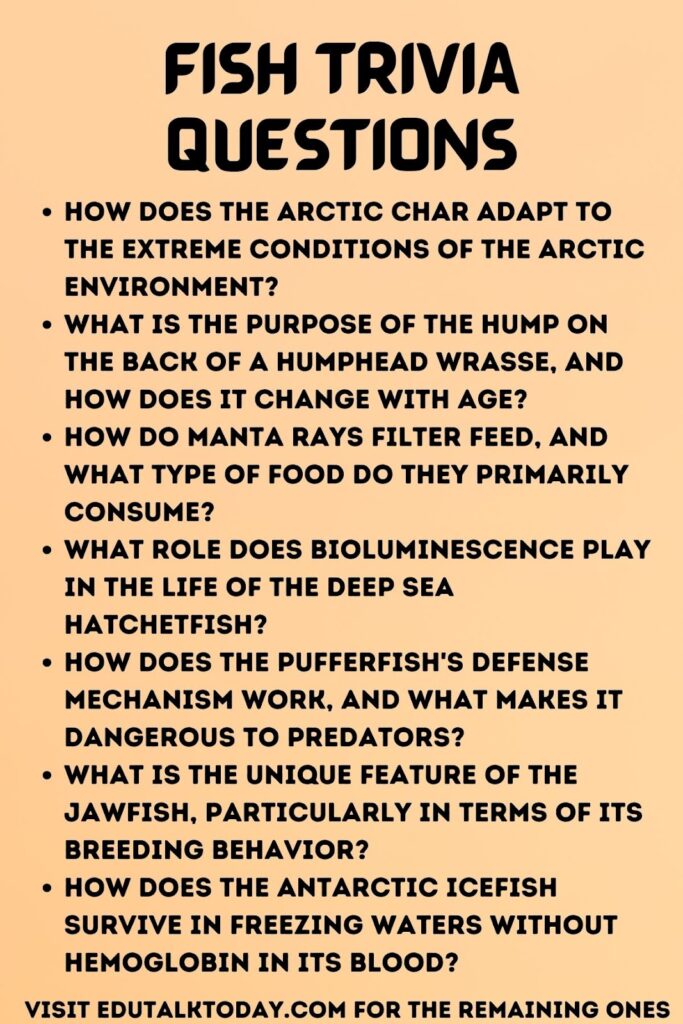36 Fish Trivia Questions

Are you a fish enthusiast or just curious about the fascinating world of aquatic creatures?
Whether you’re a seasoned ichthyologist or just a casual fish admirer, you’re in for a treat!
In this blog post, we’ll explore some exciting fish trivia questions that will test your knowledge and perhaps even teach you something new about these incredible aquatic beings.
So, let’s dive right in and discover the secrets of the underwater world!
Fish Trivia Questions
- What is the unique adaptation of the Parrotfish, and how does it contribute to the ecosystem of coral reefs?
- Can you describe the process and significance of the Salmon’s life cycle, specifically focusing on its migration and spawning behaviors?
- How do the deep-sea Anglerfish’s bioluminescence and unique mating habits aid in its survival in the ocean’s abyssal zone?
- Explain the schooling behavior of fish, particularly how it benefits individual fish in terms of hydrodynamics, predator avoidance, and foraging.
- What are the distinctive characteristics of the Coelacanth, and why was its discovery in 1938 significant to the field of ichthyology?
- How does the Electric Eel generate electricity, and what purposes does this serve in its natural habitat?
- What role does the Cleaner Wrasse play in coral reef ecosystems, and how does its behavior exemplify mutualism?
- Discuss the phenomenon of bioluminescence in deep-sea creatures, focusing specifically on the Lanternfish and its role in oceanic food chains.
- How do Clownfish and Sea Anemones exhibit a symbiotic relationship, and what mechanisms allow Clownfish to be immune to the Anemone’s stinging cells?
- What unique respiratory adaptation allows the Mudskipper to survive both in water and on land?
- How does the Arctic Char adapt to the extreme conditions of the Arctic environment?
- What is the purpose of the hump on the back of a Humphead Wrasse, and how does it change with age?
- How do Manta Rays filter feed, and what type of food do they primarily consume?
- What role does bioluminescence play in the life of the Deep Sea Hatchetfish?
- How does the Pufferfish’s defense mechanism work, and what makes it dangerous to predators?
- What is the unique feature of the Jawfish, particularly in terms of its breeding behavior?
- How do Flying Fish achieve their remarkable airborne abilities, and what is the primary purpose of this behavior?
- What is the ecological significance of the symbiotic relationship between Goby fish and Pistol Shrimp?
- How does the Antarctic Icefish survive in freezing waters without hemoglobin in its blood?
- What adaptation allows the Seahorse to be an effective predator despite its slow movement?
- How does the Archerfish hunt its prey with remarkable accuracy above the water’s surface?
- What unique method of reproduction is observed in the Banggai Cardinalfish?
- Why is the Lionfish considered an invasive species in the Atlantic Ocean, and what impact does it have on local ecosystems?
- How does the Blobfish’s unique physical structure suit its deep-sea environment?
- What distinguishes the diet of the Basking Shark from other predatory sharks, and how does it feed?
- How do Anableps, also known as “four-eyed fish,” see above and below the water simultaneously?
- What role does the male Seahorse play in reproduction, and how is this unique among fish?
- How does the Stonefish camouflage itself in its environment, and why is it considered one of the most venomous fish in the world?
- What adaptation enables the Remora, or suckerfish, to attach to larger marine animals, and how does this benefit them?
- How does the Goblin Shark catch its prey using a unique physical trait?
- What are the distinctive features of the Ribbon Eel, and how does its appearance change as it matures?
- Why are Mandarin Fish considered one of the most vibrantly colored fish, and what is unique about their skin?
- What unique feeding strategy is employed by the Whale Shark, the largest fish in the world?
- How does the Blue Tang fish contribute to the health of coral reefs?
- What unusual method of movement is displayed by the Flying Gurnard, and how does this benefit it?
- How do the schooling patterns of the Striped Marlin aid in their hunting strategy?
Answers
- Parrotfish Adaptation and Ecosystem Contribution: Parrotfish have beak-like jaws to scrape algae from coral. They excrete indigestible coral as sand, significantly contributing to the formation and maintenance of coral sand beaches and reef structures.
- Salmon Life Cycle and Migration: Salmon are born in freshwater, migrate to the ocean, then return to their birthplace to spawn. This migration is essential for their reproduction, and their spawning process contributes nutrients to the river ecosystem.
- Anglerfish Adaptations: Anglerfish use a bioluminescent lure to attract prey in deep, dark waters. Males fuse to females for reproduction, ensuring immediate availability for spawning in the deep-sea environment.
- Schooling Behavior in Fish: Schooling helps fish conserve energy, enhances foraging efficiency, and provides protection against predators by confusing them and increasing vigilance through collective awareness.
- Significance of the Coelacanth Discovery: The discovery of the living Coelacanth, previously thought extinct, was significant as it provided insights into the evolution of ancient fish and the transition of vertebrates from sea to land.
- Electricity Generation in Electric Eels: Electric Eels generate electricity using electrocytes in their bodies, producing up to 600 volts for hunting, self-defense, and navigation.
- Cleaner Wrasse in Coral Reefs: Cleaner Wrasse eat parasites off larger fish, providing a health service to other fish while gaining sustenance, exemplifying a mutualistic relationship in coral reef ecosystems.
- Bioluminescence in Lanternfish: Lanternfish use bioluminescence for communication, predator avoidance, and prey attraction. They play a crucial role in the oceanic food chain, serving as a primary food source for larger marine predators.
- Symbiosis between Clownfish and Sea Anemones: Clownfish live among the stinging tentacles of Sea Anemones, gaining protection from predators. They are immune to the anemone’s sting due to a mucus layer on their skin. In return, clownfish provide food scraps and enhance water circulation for the anemone.
- Mudskipper Respiratory Adaptation: Mudskippers have evolved to breathe through their skin and the lining of their mouth and throat, a process known as cutaneous respiration. This adaptation allows them to absorb oxygen directly from the air, enabling them to survive both in water and on muddy land.
- Arctic Char Adaptations: The Arctic Char has adapted to cold Arctic waters by developing antifreeze proteins to prevent ice crystals from forming in its blood. Additionally, they can adjust their body metabolism and feeding habits according to the season, surviving long periods with limited food availability.
- Humphead Wrasse’s Hump: The hump on a Humphead Wrasse becomes more prominent as they age, especially in males. It is thought to be a sign of maturity and dominance, playing a role in attracting mates and competitive displays.
- Manta Ray Filter Feeding: Manta Rays filter feed by swimming with their mouths open, funneling water and food (primarily plankton, small fish, and crustaceans) over gill rakers which trap the food particles while allowing water to pass through.
- Bioluminescence in Deep Sea Hatchetfish: Deep Sea Hatchetfish use bioluminescence for camouflage and predator avoidance. Their bioluminescent organs help them blend with the limited light from above, reducing their silhouette and making them less visible to predators from below.
- Pufferfish Defense Mechanism: Pufferfish can inflate their bodies by rapidly ingesting water or air. This makes them appear larger and difficult to swallow. Their skin and certain internal organs contain tetrodotoxin, a potent neurotoxin dangerous to predators.
- Jawfish Breeding Behavior: Male Jawfish are mouthbrooders, meaning they protect their offspring by carrying eggs in their mouths until they hatch. This unique behavior ensures a higher survival rate for their young in a vulnerable marine environment.
- Flying Fish Abilities: Flying Fish glide through the air on enlarged pectoral fins. They gain velocity underwater before breaking the surface and extending their fins. This behavior is primarily used to escape predators, allowing them to travel considerable distances above water.
- Goby Fish and Pistol Shrimp Symbiosis: Goby fish and Pistol Shrimp have a symbiotic relationship where the shrimp digs and maintains a burrow that both use for shelter. The Goby, with better eyesight, watches for danger and signals the nearly blind shrimp. In return, the shrimp provides a safe home for both. This partnership enhances the survival chances of both species in the ocean floor ecosystem.
- Antarctic Icefish Survival: Antarctic Icefish have adapted to their freezing habitat by not having hemoglobin in their blood. Instead, they rely on their large hearts and the increased solubility of oxygen in cold water to circulate oxygen throughout their bodies. Their blood contains antifreeze proteins to prevent ice crystal formation.
- Seahorse Predator Adaptation: Seahorses have a unique hunting mechanism involving their long snouts and rapid suction ability. They can ambush small prey by stealthily approaching and then rapidly sucking them into their mouths. Their ability to blend into their surroundings aids in this ambush strategy.
- Archerfish Hunting Technique: Archerfish hunt by shooting jets of water from their specialized mouths to knock insects and small prey off vegetation above water. They can accurately hit targets up to several feet away by adjusting for refraction at the water’s surface.
- Banggai Cardinalfish Reproduction: The Banggai Cardinalfish exhibits mouthbrooding, where the male incubates fertilized eggs in his mouth until they hatch. This protects the eggs from predators and environmental hazards during the critical development stage.
- Lionfish as an Invasive Species: Lionfish are invasive in the Atlantic Ocean due to their voracious appetite, lack of natural predators, and rapid reproduction. They prey on native fish and compete for food, disrupting local ecosystems and reducing biodiversity.
- Blobfish Physical Structure: The Blobfish has a gelatinous body with a density slightly less than water, allowing it to float above the sea floor without expending energy on swimming. This adaptation suits the high-pressure, deep-sea environment where it lives.
- Basking Shark Feeding Habits: Unlike other predatory sharks, Basking Sharks are filter feeders. They swim with their mouths open, filtering water through their gill rakers to capture plankton, small fish, and invertebrates. They can process thousands of gallons of water an hour.
- Anableps Vision: Anableps, or “four-eyed fish,” have eyes divided into two parts, allowing them to see above and below the water simultaneously. This adaptation helps them spot predators and prey in both environments.
- Male Seahorse Reproduction Role: Male Seahorses are unique in fish reproduction as they carry the fertilized eggs. The female deposits eggs into a special pouch on the male’s abdomen, where he fertilizes and incubates them until they hatch. This role reversal is rare among fish species.
- Stonefish Camouflage and Venom: The Stonefish camouflages itself by resembling a rock or coral, making it nearly indistinguishable from the sea floor. It’s one of the most venomous fish due to its dorsal fin spines that release a potent venom, used primarily for defense against predators.
- Remora Adaptation for Attachment: Remoras have a modified dorsal fin that acts like a suction cup, enabling them to attach to larger marine animals like sharks, turtles, and whales. This commensal relationship allows them to travel without expending energy and feed on scraps from their host’s meals.
- Goblin Shark’s Unique Hunting Trait: The Goblin Shark has a protrusible jaw that can extend rapidly to catch prey. This adaptation allows it to ambush prey at a distance by shooting its jaw forward with remarkable speed and precision.
- Ribbon Eel’s Distinctive Features and Maturation: Ribbon Eels are known for their elongated, ribbon-like bodies and brightly colored patterns. As they mature, their color and sex can change; juveniles are black, adult males are blue and yellow, and older individuals turn completely yellow and become female.
- Mandarin Fish’s Vibrant Coloration: Mandarin Fish are renowned for their vivid colors and intricate patterns. Their skin contains special pigment cells that create these bright colors and lacks scales, secreting a mucus that is thought to be toxic and unpalatable to predators.
- Whale Shark Feeding Strategy: Whale Sharks are filter feeders; despite their size, they feed primarily on plankton, small fish, and squid. They swim with their mouths open, filtering these small organisms through their gills as they swim.
- Blue Tang’s Role in Coral Reef Health: Blue Tangs contribute to coral reef health by feeding on algae that can otherwise overwhelm and damage coral structures. This grazing helps maintain the balance of the reef ecosystem.
- Flying Gurnard’s Movement Method: The Flying Gurnard displays an unusual method of movement by ‘walking’ along the seabed using its pelvic fins. Its large, wing-like pectoral fins, often mistaken for flying ability, are primarily used for startling predators and communicating with other Gurnards.
- Striped Marlin Schooling and Hunting: Striped Marlins often hunt in groups, using their schooling patterns to herd schools of fish or squid. This coordinated hunting strategy allows them to concentrate their prey, making it easier to catch individual fish.






